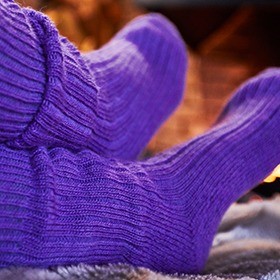At the Cambridge Sock Company, we’ve worked long and hard to source the best materials and methods to deliver a range of comfortable and practical socks that go the distance.
How our socks are made
From Fleece to Foot
- Fleece sourced from Alpacas from Peru or Angora Goats from the UK.
- Raw fleece is washed and spun into yarn.
- Fleece is dyed before being fed into the knitting machine, which comprises a cylinder around which the sock is knitted. The sock is knitted with the toe open so that all socks look like an open tube.
- After the socks are knitted, the toe is closed in a method known as hand linking, where the two part of the socks are joined using the a single thread from the same material as that used to make up the sock.
- By hand means there is a person using this machine, matching the points of the two parts point by point by hand. The resulting join is so†flat it canít be felt when worn.
- After the knitting and seaming process the socks are washed and dried. Washing removes knitting oils and residue from yarns and also helps with any shrinkage and stabilises them. The wash is done with water only; no detergent is used.
- After getting washed and dried, the socks travel to the board pairing area. Here they are pulled on flat metal foot forms (this is called the boarding), to be formed into the desired shape and size. They are then steam pressed to get their final form.
- Finally the socks are ready to be paired. Even socks produced from the same machine, using the same yarn and settings, can vary slightly, so the pairing process is important to eliminate problems that can arise at distribution.

Socks have a clock
The area on a sock around the ankle is known as the clock. It is likely that this term comes from the way the stitched or woven pattern can look like clock hands when viewed from far away.